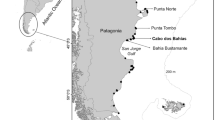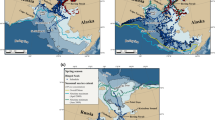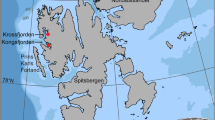Abstract
As the Antarctic Circumpolar Current crosses the South-West Indian Ocean Ridge, it creates an extensive eddy field characterised by high sea level anomaly variability. We investigated the diving behaviour of female southern elephant seals from Marion Island during their post-moult migrations in relation to this eddy field in order to determine its role in the animals’ at-sea dispersal. Most seals dived within the region significantly more often than predicted by chance, and these dives were generally shallower and shorter than dives outside the eddy field. Mixed effects models estimated reductions of 44.33 ± 3.00 m (maximum depth) and 6.37 ± 0.10 min (dive duration) as a result of diving within the region, along with low between-seal variability (maximum depth: 5.5 % and dive duration: 8.4 %). U-shaped dives increased in frequency inside the eddy field, whereas W-shaped dives with multiple vertical movements decreased. Results suggest that Marion Island’s adult female elephant seals’ dives are characterised by lowered cost-of-transport when they encounter the eddy field during the start and end of their post-moult migrations. This might result from changes in buoyancy associated with varying body condition upon leaving and returning to the island. Our results do not suggest that the eddy field is a vital foraging ground for Marion Island’s southern elephant seals. However, because seals preferentially travel through this area and likely forage opportunistically while minimising transport costs, we hypothesise that climate-mediated changes in the nature or position of this region may alter the seals’ at-sea dispersal patterns.




Similar content being viewed by others
References
Agostinelli C (2013) WLE: weighted likelihood estimation. R package version 0.9-7. CRAN package repository. http://cran.r-project.org/package=wle. Accessed 24 Nov 2013
Ansorge IJ, Lutjeharms JRE (2002) The hydrography and dynamics of the ocean environment of the Prince Edward Islands (Southern Ocean). J Mar Syst 37:107–127. doi:10.1016/S0924-7963(02)00198-7
Ansorge IJ, Lutjeharms JRE (2003) Eddies originating at the South-West Indian Ridge. J Mar Syst 39:1–18. doi:10.1016/S0924-7963(02)00243-9
Ansorge IJ, Lutjeharms JRE (2005) Direct observations of eddy turbulence at a ridge in the Southern Ocean. Geophys Res Lett 32:1–4. doi:10.1029/2005GL022588
Ansorge IJ, Pakhomov EA, Kaehler S, Lutjeharms JRE, Durgadoo JV (2009) Physical and biological coupling in eddies in the lee of the South-West Indian Ridge. Polar Biol 33:747–759. doi:10.1007/s00300-009-0752-9
Bailleul F, Charrassin J-B, Ezraty R, Girard-Ardhuin F, McMahon CR, Field IC, Guinet C (2007) Southern elephant seals from Kerguelen Islands confronted by Antarctic Sea ice. Changes in movements and in diving behaviour. Deep Sea Res Part II 54:343–355. doi:10.1016/j.dsr2.2006.11.005
Bailleul F, Cotté C, Guinet C (2010) Mesoscale eddies as foraging area of a deep-diving predator, the southern elephant seal. Mar Ecol Prog Ser 408:251–264. doi:10.3354/meps08560
Bivand R (2013) maptools: Tools for reading and handling spatial objects. R package version 0.8-27. CRAN package repository. http://cran.r-project.org/package=maptools. Accessed 2 December 2013
Boehme L, Lovell P, Biuw M, Roquet F, Nicholson J, Thorpe SE, Meredith MP, Fedak MA (2009) Technical note: animal-borne CTD-satellite relay data loggers for real-time oceanographic data collection. Ocean Sci 5:685–695
Boyd IL, Arnbom TA, Fedak MA (1994) Biomass and energy consumption of the South Georgia population of southern elephant seals. In: Le Boeuf BJ, Laws RM (eds) Elephant seals: population ecology, behavior, and physiology. University of California Press, Berkeley, pp 99–117
Bradshaw C, Hindell M, Sumner M, Michael K (2004) Loyalty pays: potential life history consequences of fidelity to marine foraging regions by southern elephant seals. Anim Behav 68:1349–1360. doi:10.1016/j.anbehav.2003.12.013
Calenge C (2006) The package “adehabitat” for the R software: a tool for the analysis of space and habitat use by animals. Ecol Modell 197:516–519. doi:10.1016/j.ecolmodel.2006.03.017
Campagna C, Le Boeuf BJ, Blackwell SB, Crocker DE, Quintana F (1995) Diving behaviour and foraging location of female southern elephant seals from Patagonia. J Zool Lond 236:55–71
Campagna C, Piola AR, Marin MR, Lewis MN, Fernández T (2006) Southern elephant seal trajectories, fronts and eddies in the Brazil/Malvinas confluence. Deep Res Part I 53:1907–1924. doi:10.1016/j.dsr.2006.08.015
Collecte Localisation Satellites (CLS) (2011) Argos User’s Manual. http://www.argos-system.org/manual/. Accessed 15 Nov 2013
de Bruyn PJN, Tosh CA, Oosthuizen WC, Bester MN, Arnould JPY (2009) Bathymetry and frontal system interactions influence seasonal foraging movements of lactating subantarctic fur seals from Marion Island. Mar Ecol Prog Ser 394:263–276. doi:10.3354/meps08292
De Szoeke RA, Levine MD (1981) The advective flux of heat by mean geostrophic motions in the Southern Ocean. Deep Sea Res Part A 28:1057–1085. doi:10.1016/0198-0149(81)90048-0
Downes SM, Budnick AS, Sarmiento JL, Farneti R (2011) Impacts of wind stress on the Antarctic Circumpolar Current fronts and associated subduction. Geophys Res Lett 38:3–8. doi:10.1029/2011GL047668
Dragon A-C, Monestiez P, Bar-Hen A, Guinet C (2010) Linking foraging behaviour to physical oceanographic structures: southern elephant seals and mesoscale eddies east of Kerguelen Islands. Prog Oceanogr 87:61–71. doi:10.1016/j.pocean.2010.09.025
Duncombe Rae CM (1989) Physical and chemical marine environment of the Prince Edward Islands (Southern Ocean) during April/May 1987. S Afr J Mar Sci 8:301–311. doi:10.2989/02577618909504569
Durgadoo JV, Ansorge IJ, Lutjeharms JRE (2010) Oceanographic observations of eddies impacting the Prince Edward Islands, South Africa. Antarct Sci 22:211–219. doi:10.1017/S0954102010000088
Durgadoo JV, Ansorge IJ, De Cuevas BA, Lutjeharms JRE, Coward AC (2011) Decay of eddies at the South-West Indian Ridge. S Afr J Sci 107:1–10. doi:10.4102/sajs.v107i11/12.673
Gallon S, Bailleul F, Charrassin J-B, Guinet C, Bost C-A, Handrich Y, Hindell M (2013) Identifying foraging events in deep diving southern elephant seals, Mirounga leonina, using acceleration data loggers. Deep Sea Res Part II 88–89:14–22. doi:10.1016/j.dsr2.2012.09.002
Gille ST (2002) Warming of the Southern Ocean since the 1950s. Science 295:1275–1277. doi:10.1126/science.1065863
Guinet C, Koudil M, Bost CA, Durbec JP, Georges JY, Mouchot MC, Jouventin P (1997) Foraging behaviour of satellite-tracked king penguins in relation to sea-surface temperatures obtained by satellite telemetry at Crozet Archipelago, a study during three austral summers. Mar Ecol Prog Ser 150:11–20. doi:10.3354/meps150011
Hijmans RJ, Williams E, Vennes C (2012) geosphere: Spherical Trigonometry. R package version 1.2-28. CRAN package repository. http://cran.r-project.org/package=geosphere. Accessed 25 Nov 2013
Hindell M, Slip D, Burton H (1991) The diving behavior of adult male and female southern elephant seals, Mirounga leonina (Pinnipedia, Phocidae). Aust J Zool 39:595–619. doi:10.1071/ZO9910595
Hindell MA, Lea MA, Morrice MG, MacMahon CR (2000) Metabolic limits on dive duration and swimming speed in the southern elephant seal Mirounga leonina. Physiol Biochem Zool 73:790–798. doi:10.1086/318104
Jonker FC, Bester MN (1998) Seasonal movements and foraging areas of adult southern female elephant seals, Mirounga leonina, from Marion Island. Antarct Sci 10:21–30. doi:10.1017/S0954102098000042
Le Boeuf BJ, Costa DP, Huntley AC, Feldkamp SD (1988) Continuous, deep diving in female northern elephant seals, Mirounga angustirostris. Can J Zool 66:446–458. doi:10.1139/z88-064
Lévy M, Klein P, Treguier A-M (2001) Impact of sub-mesoscale physics on production and subduction of phytoplankton in an oligotrophic regime. J Mar Res 59:535–565
Lima ID, Olson D, Doney S (2002) Biological response to frontal dynamics and mesoscale variability in oligotrophic environments: biological production and community structure. J Geophys Res. doi:10.1029/2000JC000393
McIntyre T, de Bruyn PJN, Ansorge IJ, Bester MN, Bornemann H, Plötz J, Tosh CA (2010) A lifetime at depth: vertical distribution of southern elephant seals in the water column. Polar Biol 33:1037–1048. doi:10.1007/s00300-010-0782-3
McIntyre T, Bornemann H, Plötz J, Tosh CA, Bester MN (2011) Water column use and forage strategies of female southern elephant seals from Marion Island. Mar Biol 158:2125–2139. doi:10.1007/s00227-011-1719-2
McMahon CR, Bester MN, Burton HR, Hindell MA, Bradshaw CJA (2005) Population status, trends and a re-examination of the hypotheses explaining the recent declines of the southern elephant seal Mirounga leonina. Mamm Rev 35:82–100. doi:10.1111/j.1365-2907.2005.00055.x
Menzel U (2013) EMT: Exact Multinomial Test: Goodness-of-Fit Test for Discrete Multivariate data. R package version 1.1. CRAN package repository. http://cran.r-project.org/package=EMT. Accessed 2 December 2013
Meredith MP, Hogg AM (2006) Circumpolar response of Southern Ocean eddy activity to a change in the Southern Annular Mode. Geophys Res Lett 33:2–5. doi:10.1029/2006GL026499
Miller PJO, Biuw M, Watanabe YY, Thompson D, Fedak MA (2012) Sink fast and swim harder! Round-trip cost-of-transport for buoyant divers. J Exp Biol 215:3622–3630. doi:10.1242/jeb.070128
Naito Y, Costa DP, Adachi T, Robinson PW, Fowler M, Takahashi A (2013) Unravelling the mysteries of a mesopelagic diet: a large apex predator specializes on small prey. Funct Ecol 27:710–717. doi:10.1111/1365-2435.12083
Nel DC, Lutjeharms JRE, Pakhomov EA, Ansorge IJ, Ryan PG, Klages NTW (2001) Exploitation of mesoscale oceanographic features by grey-headed albatross Thalassarche chrysostoma in the southern Indian Ocean. Mar Ecol Prog Ser 217:15–26. doi:10.3354/meps217015
Pakhomov EA, Froneman PW (1999) The Prince Edward Islands pelagic ecosystem, south Indian Ocean: a review of achievements, 1976–1990. J Mar Syst 18:355–367. doi:10.1016/S0924-7963(97)00112-7
Photopoulos T (2007) Behavioural changes of a long-ranging diver in response to oceanographic conditions. MSc dissertation, University of St Andrews
Pinheiro JC, Bates DM (2000) Linear mixed-effects models. In: Kimmel J (ed) Mixed-effects models in S and S-Plus. Springer, New York, pp 1–270
Pinheiro JC, Bates DM, DebRoy S, Sarkar D, The R Development Core Team (2013) nlme: Linear and nonlinear mixed effects models. R package version 3.1-113. CRAN package repository. Accessed 27 Nov 2013
Pollard RT, Read JF (2001) Circulation pathways and transports of the Southern Ocean in the vicinity of the Southwest Indian Ridge. J Geophys Res 106:2881–2898. doi:10.1029/2000JC900090
Postma M, Bester MN, De Bruyn PJN (2013) Spatial variation in female southern elephant seal mass change assessed by an accurate non-invasive photogrammetry method. Antarct Sci 25:731–740. doi:10.1017/S0954102013000059
Rintoul SR, Sokolov S (2001) Baroclinic transport variability of the Antarctic Circumpolar Current south of Australia (WOCE repeat section SR3). J Geophys Res. doi:10.1029/2000JC900107
Rintoul SR, Hughes C, Olbers D (2001) The Antarctic Circumpolar Current System. In: Siedler G, Church J, Gould J (eds) Ocean circulation and climate. Elsevier, New York, pp 271–302
Ryan PG, Bester MN (2008) Pelagic Predators. In: Chown SL, Froneman PW (eds) The Prince Edward Islands: land–sea interactions in a changing ecosystem. Sun Press, Stellenbosch, pp 121–164
Saenko OA, Fyfe JC, England MH (2005) On the response of the oceanic wind-driven circulation to atmospheric CO2 increase. Clim Dyn 25:415–426. doi:10.1007/s00382-005-0032-5
Sclater JG, Grindlay NR, Madsen JA, Rommevaux-Jestin C (2005) Tectonic interpretation of the Andrew Bain transform fault: southwest Indian Ocean. Geochem Geophys Geosyst. doi:10.1029/2005GC000951
Snaith HM, Robinson IS (1996) A study of currents south of Africa using Geosat satellite altimetry. J Geophys Res 101:18141–18154. doi:10.1029/96JC01147
Swart S, Speich S, Ansorge IJ, Goni GJ, Gladyshev S, Lutjeharms JRE (2008) Transport and variability of the Antarctic Circumpolar Current south of Africa. J Geophys Res. doi:10.1029/2007JC004223
R Core Team (2015) R: A Language and Environment for Statistical Computing. R Foundation for Statistical Computing. Vienna, Austria. http://www.R-project.org/
Tosh CA, Steyn J, Bornemann H, van den Hoff J, Stewart BS, Plötz J, Bester MN (2012) Marine habitats of juvenile southern elephant seals from Marion Island. Aquat Biol 17:71–79. doi:10.3354/ab00463
Vincent C, McConnell BJ, Ridoux V, Fedak MA (2002) Assessment of Argos location accuracy from satellite tags deployed on captive gray seals. Mar Mammal Sci 18:156–166. doi:10.1111/j.1748-7692.2002.tb01025.x
Weimerskirch H, Wilson RP, Lys P (1997) Activity pattern of foraging in the wandering albatross: a marine predator with two modes of prey searching. Mar Ecol Prog Ser 151:245–254. doi:10.3354/meps151245
Weimerskirch H, Le Corre M, Jaquemet S, Potier M, Marsac F (2004) Foraging strategy of a top predator in tropical waters: great frigatebirds in the Mozambique Channel. Mar Ecol Prog Ser 275:297–308. doi:10.3354/meps275297
Williams TM, Davis RW, Fuiman LA, Francis J, Le Boeuf BJ, Horning M, Calambokidis J, Croll DA (2000) Sink or swim: strategies for cost-efficient diving by marine mammals. Science 288:133–136. doi:10.1126/science.288.5463.133
Zuur AF, Ieno EN, Walker NJ, Saveliev AA, Smith GM (2009) Limitations of linear regression applied on ecological data. In: Gail M, Krickeberg K, Samet JM, Tsiatis A, Wong W (eds) Mixed effects models and extensions in ecology with R. Springer Science + Business Media, New York, pp 11–34
Acknowledgments
Thanks go to Arjun Amar and Tim Reid for their time and advice regarding statistical and spatial modelling technicalities, to Joachim Plötz for access to the seal tracking data, as well as to the hard-working field assistants responsible for deploying the devices since 2004. We are also extremely grateful to the assistance we received in the form of R code provided courtesy of Martin Biuw. This research was funded by the science faculty of the University of Cape Town as well as by the National Research Foundation (South Africa), and their generosity is greatly appreciated. The Alfred Wegener Institute for Polar and Marine Research (Germany) and the South African National Antarctic Programme are acknowledged for financial and logistical support. Finally, thanks to Vera for her support.
Author information
Authors and Affiliations
Corresponding author
Electronic supplementary material
Below is the link to the electronic supplementary material.
Rights and permissions
About this article
Cite this article
Massie, P.P., McIntyre, T., Ryan, P.G. et al. The role of eddies in the diving behaviour of female southern elephant seals. Polar Biol 39, 297–307 (2016). https://doi.org/10.1007/s00300-015-1782-0
Received:
Revised:
Accepted:
Published:
Issue Date:
DOI: https://doi.org/10.1007/s00300-015-1782-0




